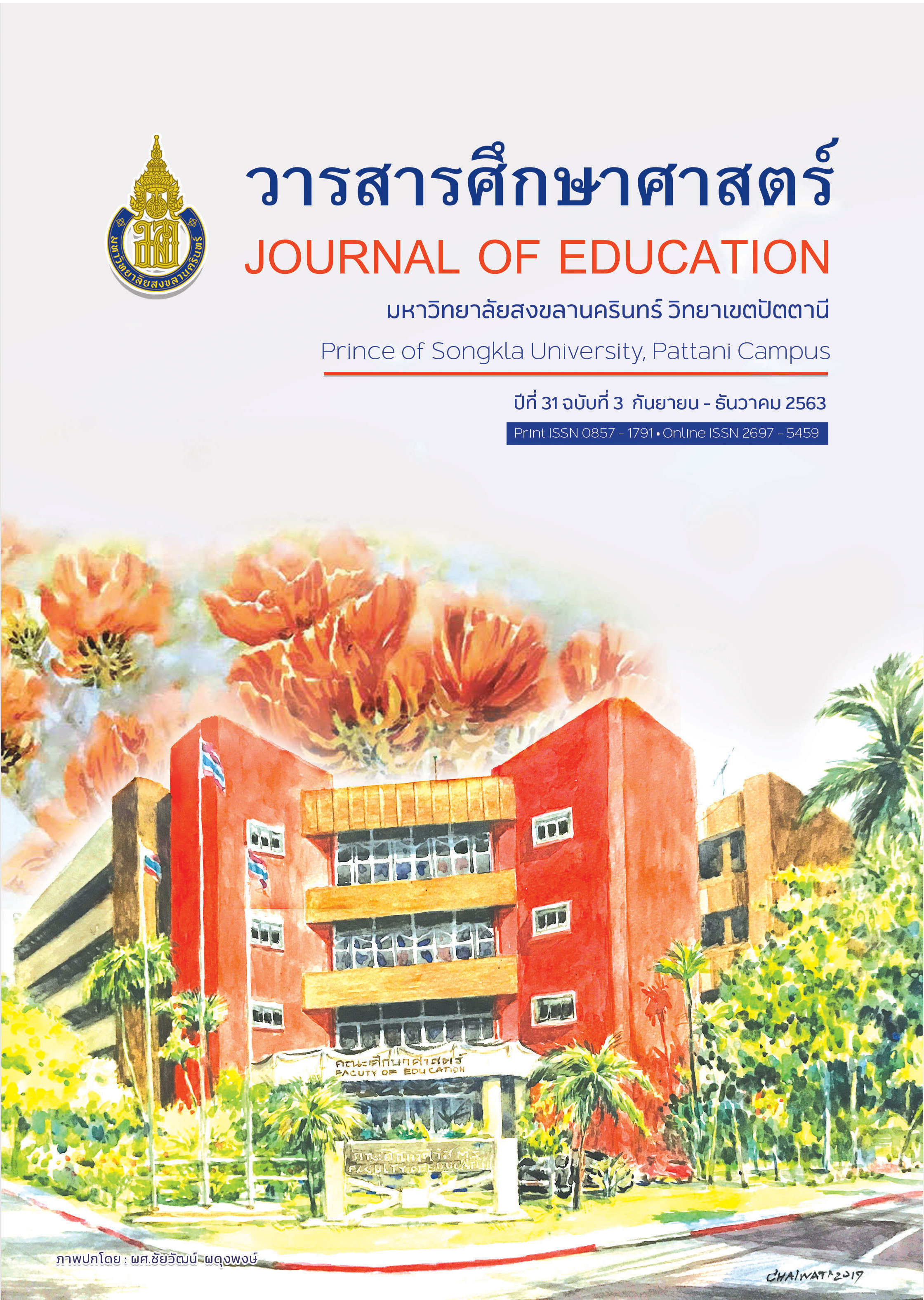Developing General English Instruction at Rajamangala University of Technology Srivijaya with Reflections on the Use of English for Work by New Graduates
Main Article Content
Abstract
This study was conducted to examine the instruction of General English Courses at Rajamangala University of Technology Srivijaya (RUTS) and to investigate the use of English for work by new graduates. Research data were collected by questionnaires gained from the new 580 graduates of RUTS in academic year 2019. Data analysis employed descriptive statistics: frequency, percentage, mean, and standard deviation. It was found that (1) the four aspects of General English instruction at RUTS including instructional materials ( =3.90), course contents ( =3.89), instructors ( =3.85), and instructional practices ( =3.80) were at a high level of appropriateness from the new graduates’ perspective and (2) three skills in the use of English for work: reading ( =3.80), writing ( =3.80), and conversation ( =3.74) were also at a high level of use by the new graduates. Based on the eight groups of their study fields, inferential statistics, a one-way analysis of variance (ANOVA) was used to inspect the difference among means of appropriateness of General English instruction and the use of English for work attained by the eight groups. The study found significant difference at the 0.01 level among means of the two issues. The findings used for curriculum development suggested that next revising General English Courses at RUTS should be considered by both English Foundation and English for Specific Purposes which relate to the contexts of communication in particular study fields. This is to encourage the learners’ practicing English for communication in particular contexts and to drive learning University English into communicative pratices more relating to their study fields.
Article Details
References
กมลภู สันทะจักร์ และกนกศักดิ์ สุขวัฒนาสินิทธิ์. (2561). คุณลักษณะนักบัญชีที่พึงประสงค์ในยุคไทยแลนด์ 4.0 ของหน่วยงานราชการในประเทศไทย. วารสารมหาจุฬานาครทรรศน์, 5(3), 71-789.
กฤษณะ โฆษชุณหนันท์. (2559). การใช้ภาษาอังกฤษเพื่อการสื่อสารของวิศวกรไทย: กรณีศึกษาบริษัทญี่ปุ่นในนิคมอุตสาหกรรมอมตะนคร. สุทธิปริทัศน์, 30(93), 146-159.
จิรารัตน์ ประยูรวงษ์. (2562). DIGITAL LEARNING การเรียนรู้ภาษาอังกฤษบนโลกดิจิทัลในศตวรรษที่ 21.วารสารบัณฑิตศึกษา มหาวิทยาลัยราชภัฏวไลยอลงกรณ์ ในพระบรมราชูปถัมภ์, 1 (1), 210-224
ชัยวัฒน์ แก้วพันงาม. (2559). เทคโนโลยีเพื่อการประเมินการเรียนรู้ภาษาสำหรับผู้เรียนในศตวรรษที่ 21. Veridian E-Journal, Silpakorn University, 9(3), 436-452.
ชลธิชา นางงาม. (2551). ปัญหาและอุปสรรคด้านการเรียนการสอนวิชาภาษาอังกฤษ 1 ของนักศึกษาและอาจารย์คณะวิศวกรรมศาสตร์ มหาวิทยาลัยเทคโนโลยีราชมงคลธัญบุรี. สารนิพนธ์. กรุงเทพฯ: บัณฑิตวิทยาลัย มหาวิทยาศรีนครินทรวิโรฒ.
ณรัฐพล สุเภากิจ และเทิดศักดิ์ เตชะกิจขจร. (2561). แนวทางการบริหารวิชาชีพของสถาปนิกฟรีแลนซ์ในประเทศไทย. สาระศาสตร์, 1, 23-35.
เพ็ญประภา เจริญสุข และอนุวัติ เจริญสุข. (2553). ภาษาอังกฤษกับการขับเคลื่อนเศรษฐกิจไทยสู่ความเป็นประชาคมเศรษฐกิจอาเซียน 2015. สืบค้นเมื่อ 16 พฤศจิกายน 2562, จาก http://www.bu.ac.th/knowledgecenter/executive_journal/oct_dec_11/pdf/aw07.pdf
มหาวิทยาลัยเกษตรศาสตร์. ฝ่ายบริการการศึกษา. (2562). ตารางจัดกลุ่มย่อย เพื่อใช้ในการจัดกลุ่มสาขาวิชาของมหาวิทยาลัยเกษตรศาสตร์. สืบค้นเมื่อ 16 ตุลาคม 2562. จาก https://eduserv.ku.ac.th//001/ISCED/ISCED-group.xls
หาวิทยาลัยเทคโนโลยีราชมงคลศรีวิชัย. กองนโยบายและแผน. (2561). แผนพัฒนายุทธศาสตร์การพัฒนามหาวิทยาลัยเทคโนโลยีราชมงคลศรีวิชัย ระยะปานกลาง 5 ปี พ.ศ. 2561 - 2565. สงขลา: มหาวิทยาลัยเทคโนโลยีราชมงคลศรีวิชัย.
มหาวิทยาลัยเทคโนโลยีราชมงคลศรีวิชัย. ฝ่ายวิชาการ (2558). หลักสูตรหมวดวิชาศึกษาทั่วไป พ.ศ. 2558. สืบค้นเมื่อ 16 ตุลาคม 2562. จาก https://reg.rmutsv.ac.th/course/file/course_development/Gen_Education_Course_2558.pdf
เยาวลักษณ์ ยิ้มอ่อน. (2557). การใช้ภาษาอังกฤษในการประกอบอาชีพของบัณฑิตไทยในเขตกรุงเทพมหานคร. วารสารปัญญาภิวัฒน์, 5(2), 191-204.
ยุพาภรณ์ พิริยศิลป์ (2559). ปัจจัยที่มีผลต่อความสำเร็จหรือล้มเหลวในการเรียนภาษาอังกฤษ: กรณีศึกษารายวิชาภาษาอังกฤษพื้นฐาน มหาวิทยาลัยเทคโนโลยีราชมงคลอีสาน วิทยาเขตขอนแก่น. วารสารศึกษาศาสตร์ มหาวิทยาลัยสงขลานครินทร์ วิทยาเขตปัตตานี, 27(1), 37-56.
สมบัติ คชสิทธิ์, จันทนี อินทรสูต และธนกร สุวรรณพฤฒิ. (2560). การจัดการเรียนรู้ภาษาอังกฤษให้กับผู้เรียนยุค THAILAND 4.0. วารสารวไลยอลงกรณ์ปริทัศน์ (มนุษยศาสตร์และสังคมศาสตร์). 7(2), 175-186.
สาธิตา วัฒนโภคากุล. (2556). ความคิดเห็นของนิสิตคณะสัตวแพทยศาสตร์ที่มีต่อรายวิชาภาษาอังกฤษสำหรับสัตวแพทย์ 1 ของสถาบันภาษา จุฬาลงกรณ์มหาวิทยาลัย. ภาษาปริทัศน์ 2556,18-41.
สาวิตรี ม่วงใหญ่ ไรลีย์ และบุษบา กนกศิลปธรรม. (2562). การพัฒนาระบบเทคโนโลยีเพื่อการเรียนรู้และทักษะภาษาอังกฤษ: ไวยากรณ์. Veridian E-Journal, Silpakorn University, 12(4), 1021-1038.
อดิศา เบญจรัตนานนท์. (2560). การจัดการเรียนการสอนภาษาอังกฤษพื้นฐาน มหาวิทยาลัยสงขลานครินทร์วิทยาเขตปัตตานี: เสียงสะท้อนจากผู้เรียนและผู้สอน. วารสารวิชาการศึกษาศาสตร์ มหาวิทยาลัยศรีนครินทรวิโรฒ, 18(2), 293-315.
อริยา คูหา, สรินฎา ปุติ และฮานานมูฮิบบะตุดดีน นอจิ. (2562). โลกที่เปลี่ยนแปลง การเรียนรู้ที่ผ่านสู่ Active Learning. วารสารศึกษาศาสตร์ มหาวิทยาลัยสงขลานครินทร์ วิทยาเขตปัตตานี, 30(2), 1-13.
Crystal, D. (2003). English as a global language. (2nd ed.). Cambridge: Cambridge University Press.
Dudley-Evans, T. & St. John, M.J. (1998). Developments in English for Specific Purposes: A multi-disciplinary approach. Cambridge: Cambridge University Press.
Harmer, J. (2007). The Practice of English Language Teaching. (4th ed.). London: Longman
Hutchinson, T. & Walters, A. (1998). English for specific purposes: A learning-centered approach. Cambridge: Cambridge University Press.
Soranastaporn, S. (2018). ESP in Thailand: Practical English Training for Professionals. Liberal Arts Journal, Mahidol University, 1(1), 7-28.
Stanley, G. (2013). Language Learning with Technology: Ideas for integrating Technology in the Classroom. Cambridge: Cambridge University Press.
Walker, A. & White, G. (2013). Technology Enhanced Language Learning: Connecting Theory and Practice. Oxford: Oxford University Press.
Yamane, T. (1976). Statisctic, An Introductory Analysis (2nd ed.). New York: Harper & Row.


